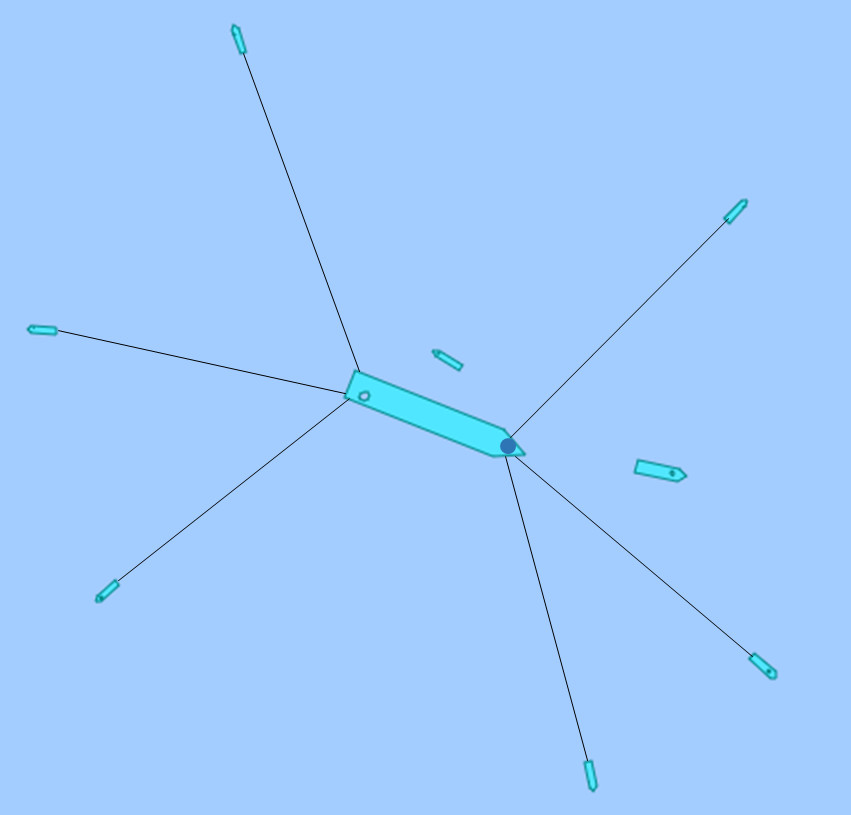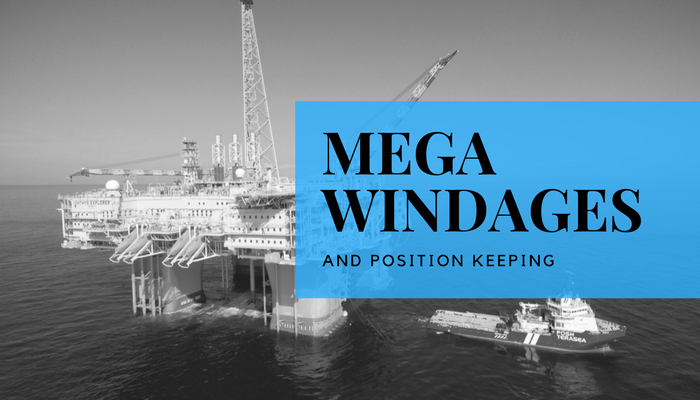January 24, 2018
The following Insight from Mike Priestly, Senior Consultant, explores the effect of large windages on the nature of position keeping two of the largest floating facilities ever built:
Last year, two of the largest facilities in each class were installed in the Northern waters of Australia, the Inpex Ichthys CPF “Ichthys Explorer” and Shell FLNG “Prelude”. If you are quick, you will see the tugs on station for the position keeping of Prelude at (link). Last year you would have seen an image similar to that shown in Fig 3 but without the marked-up tug lines. In this blog we share our experience with the enormous windages and position keeping engineering of these enormous floaters.
Mega Projects – Mega Floaters
The Ichthys Explorer is a semi-submersible Central Processing Platform (CPF) in square shape of 120m length and breadth. The Ichthys Explorer has 7 underwater fairleads on each of the 4 columns making a total of 28 mooring legs. It is moored on a fixed heading allowing the risers and umbilicals to run from the CPF, across the subsea Riser Support Structure (RSS) and into the field. It was towed at a draft of 15m and installed through connection to the pre-installed mooring system at a draft of 19m. An overview video showing the size of the CPF tow is shown in this INPEX video.
The Shell “Prelude” is a 488m long and ship shaped floater with a beam (width) of 74m and was towed at draft of 12m. When ballasted and mooring lines connected, it sits around a draft of 19m. Prelude has an enormous windage when beam on and is connected to the mooring system through a huge rotating turret near the bow. The turret allows Prelude to weathervane (keep its head toward the weather) thereby reducing loads on the 4 groups of 4 mooring lines. An overview video of FLNG Prelude hook up activities showing the scale of FLNG can be seen in the following Shell Shell video.
The Nature of Position Keeping
During hook up of the mooring system, each vessel must be held in position close to the mooring centre using a spread of tugs. At medium to high winds speeds the loads on the facilities are dominated by the wind induced forces. At lower wind speeds, the loads are similar in magnitude to the combined current (dominant) and wave induced forces (minor) on the hull. Wind and wave loads are generally constant during the day and usually change slowly in magnitude and direction. However, current induced forces are influenced by the tide and other factors, changing direction and magnitude around the clock.
During mooring hook up operations, the combined hull forces and tug loading scenarios require careful engineering and simulation to demonstrate and practice adequate control. The mooring fairlead positions and heading of the vessel are critical for extended durations, particularly during initial mooring line hook up. Changes in the combined force vector must be countered by position keeping masters requesting tug changes in bollard pull and heading.
Windage Profiles
As can be seen from the windage profiles in Fig 1, the windage of the Ichthys Explorer is pretty much symmetrical. However, Prelude has a slightly smaller bow/stern windage profile then the COF but has a very large side windage profile. Representative windages are shown in Fig 1 below:
Fig 1 – Indicative Windage Profiles
Position Keeping for Mooring Hook Up
As mentioned, during mooring hook up, the facility needs to be held at a constant heading with limited heading variability for significant durations. As you would imagine, the implications and challenges of managing this during position keeping for Prelude and the Ichthys Explorer are quite different. For example, the loads induced for the Ichthys Explorer as the heading changes slightly from bow to quarter will have little difference, but with the Prelude the loads and required tug bollard pull increase significantly.
To emphasize the challenges and differences between the two projects, the respective windages and plotted estimated wind loads versus headings are shown in Fig 2 below:
Fig 2 –CPF and FLNG Wind Loads Versus Headings
Importantly, the graphs show that head on (bow at 180 degrees), Prelude has a smaller windage area and therefore less resultant wind load. However, this increases enormously as the heading moves around to 90 degrees (beam on). On the other hand, the Ichthys Explorer has significantly less change in wind load as heading changes. Current inducted loads follow similar patterns. Therefore, maintaining operability during hook up, of Prelude while maintaining a fixed heading with the environment changing direction can be quite a challenge.
At ONA we routinely analyse vessel positioning to support mooring hook up. Using analysis techniques based on the measured and historical environmental load conditions, including wind, wave and current, we advise on the preferred tug size and configurations to enhance operability and control outcomes thereby minimising risk. This work is done using a combination of static and dynamic analysis to provide the best load control and operability outcomes.
As consultants, we like to see our engineering and philosophies translated to the real world through execution offshore. Shown in Fig 3. is a screen capture from Vessel Finder (www.vesselfinder.com) showing Prelude being positioned using six tugs. The tug orientation is arranged to hold Prelude in position for what looks like a South Westerly dominated sea state on August 4th 2017. The mooring installation vessel Deep Orient DSV is shown working the mooring line connection near the bow and there is a supply vessel alongside immediate abeam of midships.
Fig 3 – Vessel Finder Web Page Screenshot (Lines Added)
Over the last ten years ONA have provided world class position keeping and mooring engineering, in Australia, to projects/vessels including Northern Endeavour FPSO, Cossack Pioneer FPSO, Stybarrow Venture FPSO, Dampier Spirit FSO, Prelude FLNG, Atwood Eagle, Safe Astoria, Songa Venus and Ensco 5003. See model samples here.






